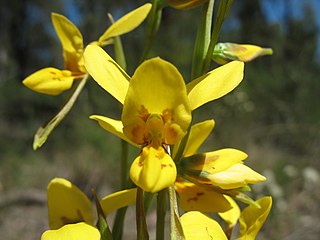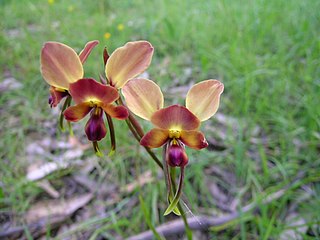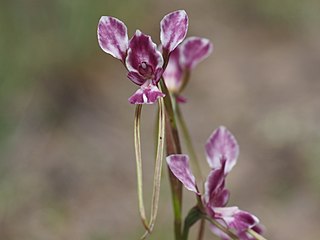
Diuris sulphurea, commonly called the tiger orchid or hornet orchid, is a species of orchid which is endemic to eastern Australia. It has up to three leaves, and a flowering stem with up to seven bright yellow flowers with dark brown markings.

Diuris protena, commonly known as northern golden moths, is a species of orchid which is endemic to Victoria. It has a tuft of between four and eight leaves at the base and up to three mostly yellow flowers with a few light-coloured marks. It is classed as "endangered" in Victoria.

Diuris chryseopsis, commonly known as common golden moths or the small snake orchid, is a species of orchid that is endemic to south-eastern Australia. It is a common and widespread species growing in woodland, often in colonies and has up to four drooping, golden-yellow flowers. It is similar to several other orchids and form hybrids with some other Diuris species.

Diuris aurea, commonly known as the golden donkey orchid, is a species of orchid which is endemic to Australia, growing in New South Wales and Queensland. It has one or two leaves at the base and two to five golden-yellow to orange flowers with some darker markings.

Diuris orientis, commonly called the wallflower orchid or eastern wallflower orchid, is a species of orchid which is endemic to eastern Australia. Like others in the genus Diuris, it has two ear-like petals and is similar to the common donkey orchid of Western Australia with which it has been confused. This species is found in New South Wales, Victoria, South Australia and Tasmania and its stalk-like petal "claw" is shorter in than those of D. corymbosa.

Diuris alba, commonly called the white donkey orchid, is a species of orchid which is endemic to eastern Australia. It has up to three leaves, and a flowering stem with up to seven white flowers with purplish markings.

Diuris abbreviata, commonly known as the lemon doubletail, is a species of orchid that is endemic to eastern Australia. It has two or three leaves and a flowering stem with up to nine yellow flowers with darker markings.

Diuris dendrobioides, commonly known as the wedge diuris, is a species of orchid which is endemic to eastern Australia. It has one or two leaves and a flowering stem with up to six pale lilac-coloured to mauve flowers with darker markings.

Diuris magnifica, commonly called the large pansy orchid is a species of orchid which is endemic to the south-west of Western Australia. It has large, colourful flowers and is common in a narrow range near the coast around Perth, often occurring with the similar but smaller Diuris corymbosa.
Diuris amplissima, commonly called the giant donkey orchid is a species of orchid that is endemic to the south-west of Western Australia. It is a rare species and the largest Diuris in Western Australia. It has two or three leaves at its base and up to seven purple and dull yellowish-brown flowers on a tall flowering stem.
Diuris brevissima is a species of orchid which is endemic to New South Wales. It has two folded leaves and up to nine light yellow flowers with reddish-brown markings. It is a poorly known species that has only been recorded in the Blue Mountains.
Diuris chrysantha, commonly known as granite donkey orchid, is a species of orchid that is endemic to eastern Australia. It has one or two leaves and up to seven deep golden to orange-coloured flowers with brown markings and occurs on the ranges and tablelands north from Tamworth to the Darling Downs.
Diuris eburnea is a species of orchid that is endemic to the south-west of Western Australia. It has between four and six linear leaves and up to eight pale yellow to cream-coloured flowers with reddish markings. It is only known from near the Arrowsmith River north of Eneabba.
Diuris fucosa is a species of orchid that is endemic to New South Wales. It between four and seven leaves and up to four pale yellow flowers with a few brown striations. It is only known from two sites in Callitris woodland in the south of the state and is classed as "extinct" in Victoria.
Diuris immaculata, commonly known as the little Esperance bee orchid, is a rare species of orchid that is endemic to the south-west of Western Australia. It has between four and six leaves and up to three golden yellow flowers without markings. It is only known from near Esperance.
Diuris micrantha, commonly called the dwarf bee orchid or tiny bee orchid, is a rare species of orchid which is endemic to the south-west of Western Australia. It has four to six linear leaves at its base and up to six yellow flowers with reddish brown markings. It grows in swampy places south of Perth.
Diuris luteola, commonly called the northern doubletail, is a species of orchid which is endemic to Queensland. It has a single linear leaf at its base and up to six pale yellow flowers with a few brown markings. It grows in shallow, stony soil on tablelands in eastern parts of the state.
Diuris oporina, commonly called the autumn donkey orchid or northern white donkeys tails is a species of orchid that is endemic to Queensland. It has a single tapering, linear leaf at its base and up to ten white flowers with mauve to purple markings. It grows in the drier parts of the tablelands in Far North Queensland.
Diuris platichila, commonly known as the Blue Mountains doubletail, is a species of orchid that is endemic to a few isolated places in the Blue Mountains in New South Wales. It has two leaves and up to eight yellow flowers with dark markings on the dorsal sepal and labellum. It has relatively long, thin lateral sepals and the central lobe of the labellum is wedge-shaped. It forms hybrids with other species of Diuris.

Diuris pulchella, commonly called the beautiful donkey orchid is a species of orchid that is endemic to the south-eastern part of the south-west of Western Australia. It has two or three leaves at its base and up to five bright yellow and mauve flowers described as "exquisite", "spectacular" and "attractive". It grows in shallow soil on granite outcrops near Esperance.









